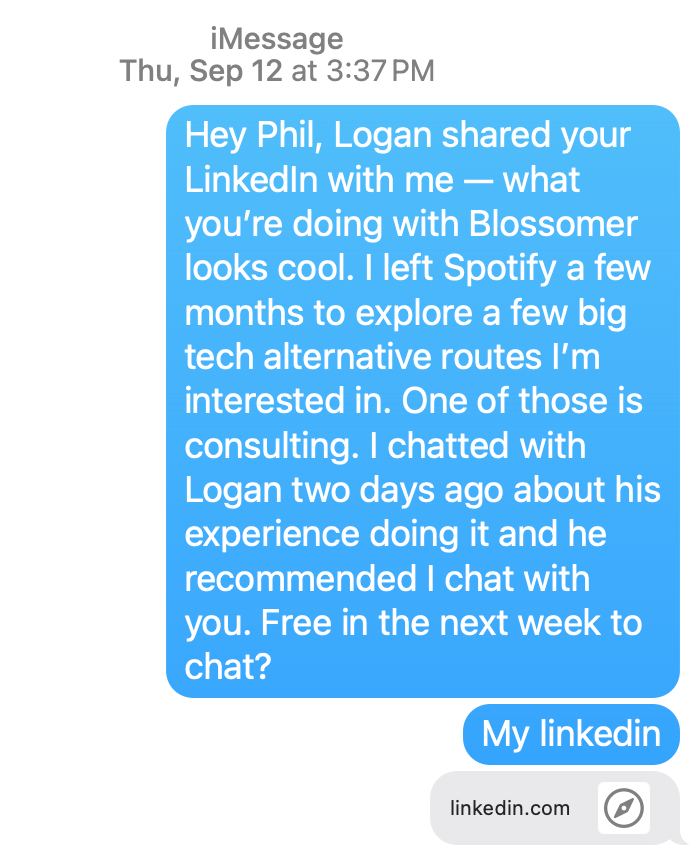3 months ago I quit my job at Spotify with nothing lined up.
I was a senior product manager on a cool team working with nice people making six figures.
And I left that to… practice my Spanish in Colombia?
My parents, generally accepting of my shenanigans, had questions.
“Isn’t this like your fourth gap year?” My dad asked. “Aren’t you a little old for that?”
“How are you going to find a wife with no job?” My mom inquired, grandkids on the brain. “Smart women expect you to have a job.”
I had a plan, I assured them: travel for a bit, then figure out my next move.
In my last two posts, I wrote about my travels to Colombia and Los Angeles.
In this post, I share what I’ve decided to do next and how I made that decision.
Spoiler: I’ve decided to move to London in January 2025 and work on starting a company 🇬🇧.
Standing on this side of that decision, it’s easy to tell myself that’s always where I was going to land.
In truth, my last few months have been anything but certain.
Here are the steps I took to come to that decision:
Reflect on my values, goals, strengths, and prior work experiences
Brainstorm list of possible jobs
Create criteria to prioritize
Gather data on finalists via interviews, ChatGPT
Choose, and fully commit
Step 0: Reflect on my values, goals, strengths, and prior work experiences
I wanted to ground my thinking in my values, my near term life goals, what my strengths are, and what work I’ve gotten energy from in the past.
Getting clear on my values and then seeking to align future plans with those values was step one. My values: curiosity, kindness, humor, truth, fairness. Done.
Next was clarifying my near-term life goals. What do I want my life to look like? From there, how does my work fit in?
Thinking about my strengths was also key. Like many recovering perfectionists, I tend to think a lot about my weaknesses. An incomplete list: I’m late a lot, I overthink, I’m bad at remembering the names of my friends’ friends, I’m lactose intolerant.
But as any LinkedIn Tech Bro will tell you… yOu gOttA foCuS oN yOur sTreNgtHs!!1!1!
So, I spent time reflecting on my strengths. I asked:
what do I view as my own strengths?
what positive feedback have received repeatedly at work?
what do close friends view as my strengths?
My strengths? Connecting with people, communicating, stubborn problem solving, consistently growing as a person and professional, humility, insatiable curiosity.
I also used ChatGPT and Perplexity to generate a list of questions getting at my values and work preferences and wrote out my answers to them.
Here are the questions I used. Feel free to steal.
Doing this was helpful and fun. After a few drafts, I noticed few new insights were coming out. I was ready to move on. It was time to #brainstorm.
Step 1: Brainstorm a list of possible jobs
I love a good brainstorm. It’s like improv, which I love, but you get the bonus dopamine of feeling productive. WHAMMY!!
My goal was to come up with a bunch of different jobs I could potentially do.
I’m a firm believer in quantity as a path to quality so I challenged myself to come up with over 20 unique roles.
Without worrying about priority order just yet, I wrote down a list of 30 roles, some obvious, some non-obvious. Here’s the actual list I created:
PM at a startup
Entrepreneur
PM Consultant / Fractional Head of Product / Content Creator
Venture capitalist
Philosophy professor
Business school professor
Lawyer
Professional athlete
Product designer
User researcher
Software engineer
High school teacher
Musician
Tutor
UX writer
Data scientist
Book author
Politician
Student
Chief of Staff
Psychologist
Therapist
Journalist
Non-profit director
Marketing
Salesperson
English teacher in foreign country
Drug dealer
Career coach
I had my starting list. Now I needed a way to identify my favorites.
Step 2: Create criteria to prioritize
To a hammer, everything looks like a nail.
I’ve worked as a product manager for the last 9 years. To me, (pretty much) everything looks like a list to be prioritized via an objective three-part criteria.
Here’s the criteria I came up with:
I’ll enjoy it
I’ll be good at it
It will enable the lifestyle I want
I considered including “what the world needs” but decided against it. There are so many ways to make the world a better place, irrespective of your job.
I then basically rated each job according to those three criteria. Pretty much right away I was able to eliminate most options. Here’s what that looked like for me:
I scored “I’ll like it” and “I’ll be good at it” on a scale of Small (S), Medium (M), and Large (L). For example, for Professional Athlete, under “I’ll be good at it” I wrote S for small: I don’t think I have what it takes to be a professional athlete 🥲.
Meanwhile, I scored “It enables my desired lifestyle” on a binary Yes (Y) or No (N). To do this, I thought about what of a great week in my life looked like, then how much that would cost, then how much I’d make in that job, and outputted a yes or no.
Finally, I added question marks to indicate uncertainty – more question marks meant more uncertainty – and added a preliminary cutline.
And… voilà. I had my eight finalists.
Step 3: Gather data on finalists: interviews, ChatGPT
Now that I had my final eight options, it was time to gather some data. I did this via informational interviews with friends in these jobs and ChatGPT’ing.
For each conversation, I ran the same playbook, optimized to respect the person’s time and help me get the most out of the conversation.
My playbook:
Send person a message noting mutual connection if we’re not already friends, evidence that I’ve done a bit of research on them, explain where I’m at, my goal, what specific thing I want to talk with them about, why they’re uniquely a great person to talk to, end with clear ask to chat.
If they say yes (90% of the time they said yes), efficiently find time to chat by sharing my calendly link while also offering to chat at alternative times. They’re doing me a favor by chatting with me so it’s incumbent on me to work around their schedule.
Before: prepare specific, personalized questions
During: be on time, start with intros, then go through my specific, personalized questions, take notes throughout, ask what they’re working on, what’s hard, then proactively try to help with an offer of advice or intro, end on time or early.
After: send brief thank you note and try to help them with whatever hard thing their wrestling with
I had ~25 conversations with people doing the jobs in my top list and found them mostly very fun and very helpful.
I had collected enough data. It was time for the final step: decide and commit.
[Final step!] Step 4: Choose, and fully commit
You can alway gather more data. You can always think more. Eventually, you need to make a decision.
It was time to put a stake in the ground. The first thing I decided was, ironically, not job related. Although I’d wanted to move to London eventually, I didn’t yet have a move date.
At first this openness felt fun and cool (so nomad!). However, in time it just made deciding everything else really hard… it left too many important variables up in the air.
“I’m going to move to London this December.” -Me to myself.
I decided that mid September 2024 on a hike with my Mom and brother. Selfie from said hike:
I considered extending my stay in Los Angeles – it’s very sunny here. But I knew I wanted to move to London eventually… and delaying that just felt like putting my life on hold.
I want(ed) to start putting down roots socially, professionally, romantically, and I felt I couldn’t do that in a city I planned to leave shortly.
It was time to go. London was calling.
So, I decided I would move to London in December 2024. (December 2024 would become January 2025 once I got started on my visa.)
Now it was time to figure out what I was going to “do” in London.
By that point, there were a few finalists. I wanted to either:
join an ai b2b startup in London as a founding product manager
try out venture capital
give the solopreneur life a go (consulting, courses, fractional CPO, paid newsletter etc.)
retrain in product design, or
take another swing as a founder.
I chose the founder route because of what it is and what it is not.
What it is: the job I’ve enjoyed most, the job a lot of people I admire have chosen, something that’ll only get harder to do when I have more life responsibilities like kids, something that sets me up well to do those other things later.
What it is not: another PM job.
I’ve done product for almost a decade and, while I’ve learned a ton, wanted to try something else.
In terms of trying out investing… I don’t feel I have the first-hand startup experience or gargantuan network to be exceptionally helpful to founders.
I think it’s a cool job that can help great companies get built. But if I do it, I’ll do it later.
Right now, I’m keen to build.
We’re living in a special moment in time when new technologies like generative AI have created so many new significant problems and ways of solving those problems, as well as drastically reducing the time and cost required to validate those ideas.
Decision. Made.

Epilogue: what I’m building, raising money, moving logistics
I haven’t decided what I’m building or who I’m building for. Consumer or b2b? Haven’t decided. FinTech or Healthcare? TBD. AI in the company name? You bet ;)
I plan to spend my first few months exploring problems and sectors I’m interested in.
My goal is to build conviction in a problem space via customer interviews, market analysis, and manual services offered and paid for.
I’m currently raising a bit of money to cover living expenses and figuring out visa and moving logistics.
I just started looking for an apartment and a roommate in North London. If you know anyone looking, please let me know!
Until next time,
Lachlan









What a great framework! Making me feel quite validated in my journey as an entrepreneur too. :)
I loved reading this - as someone who went through a (similar) journey, this post only validated the way I made my decision! Thanks Lachlan - would love to connect w you on LinkedIn.